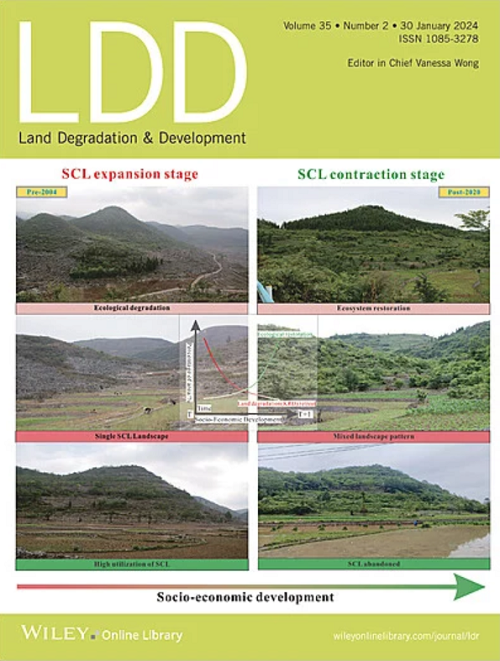土地利用诱导养分积累和细菌多样性变化的土壤酶活性化学计量学研究
IF 3.6
2区 农林科学
Q2 ENVIRONMENTAL SCIENCES
引用次数: 0
摘要
土壤酶是有机物催化分解的限速步骤,控制着土壤养分循环的过程和效率。尽管土壤微生物在农业管理和减缓气候变化方面发挥着至关重要的作用,但我们对土壤微生物调节农业土壤养分循环的酶介导机制的了解仍然有限。本研究探讨了农业和自然生态系统中与碳(C)、氮(N)和磷(P)循环相关的胞外酶活性模式及其驱动因素。结果表明,柑橘栽培显著降低了土壤细菌群落多样性。与天然林土壤相比,柑橘种植土壤的速效氮和速效磷水平显著提高,这与C和P获取酶活性降低和N获取酶活性增加相对应。回归分析表明,土壤C -和P -获取酶活性与细菌多样性呈正相关,而N -获取酶活性与细菌多样性呈负相关。相反,氮获取酶活性与土壤氮、磷有效性呈正相关,而碳、磷获取酶活性呈负相关。这些结果表明,胞外酶活性对土壤养分有效性和微生物多样性的变化有高度的响应。酶载体分析进一步表明,随着土壤细菌多样性的减少,微生物养分限制由磷转向氮。这种转变主要是由柑橘诱导的细菌多样性下降所驱动的,导致微生物氮限制增强。受土壤pH值、有效磷和细菌多样性影响的微生物养分限制的转变对土壤肥力管理具有重要意义,特别是在提高土壤酶活性以减少化肥使用和支持气候智能型农业面对全球环境挑战方面。本文章由计算机程序翻译,如有差异,请以英文原文为准。
Land Use‐Induced Changes in Nutrient Accumulation and Bacterial Diversity Shift Stoichiometry of Soil Enzyme Activity
Soil enzymes are the rate‐limiting steps in the catalytic breakdown of organic matter, governing the process and efficiency of nutrient cycling in soil. Despite their crucial role in agricultural management and climate change mitigation, our understanding of the enzyme‐mediated mechanisms by which soil microorganisms regulate nutrient cycling in agricultural soils remains limited. This study investigated patterns of extracellular enzyme activities related to carbon (C), nitrogen (N), and phosphorus (P) cycling, along with their driving factors, in both agricultural and natural ecosystems. Our results indicated that citrus cultivation significantly reduced soil bacterial community diversity. Compared with natural forest soils, citrus‐planted soils exhibited markedly higher levels of available nitrogen and phosphorus, which correspond with decreased activities of C‐ and P‐acquiring enzymes and increased activity of N‐acquiring enzymes. Regression analyses revealed that the activities of soil C‐ and P‐acquiring enzymes were positively correlated with bacterial diversity, whereas N‐acquiring enzyme activity was negatively associated with bacterial diversity. In contrast, N‐acquiring enzyme activity was positively correlated with the availability of soil N and P, while C‐ and P‐acquiring enzyme activities showed negative correlations. These findings suggested that extracellular enzyme activities are highly responsive to variations in soil nutrient availability and microbial diversity. Enzyme vector analysis further indicated that as soil bacterial diversity decreased, microbial nutrient limitation shifted from phosphorus to nitrogen. This transition is primarily driven by citrus‐induced decline in bacterial diversity, resulting in enhanced microbial nitrogen limitation. The shift in microbial nutrient limitation, influenced by soil pH, available phosphorus, and bacterial diversity, has significant implications for soil fertility management, particularly in enhancing soil enzyme activity to reduce chemical fertilizer use and support climate‐smart agriculture in the face of global environmental challenges.
求助全文
通过发布文献求助,成功后即可免费获取论文全文。
去求助
来源期刊

Land Degradation & Development
农林科学-环境科学
CiteScore
7.70
自引率
8.50%
发文量
379
审稿时长
5.5 months
期刊介绍:
Land Degradation & Development is an international journal which seeks to promote rational study of the recognition, monitoring, control and rehabilitation of degradation in terrestrial environments. The journal focuses on:
- what land degradation is;
- what causes land degradation;
- the impacts of land degradation
- the scale of land degradation;
- the history, current status or future trends of land degradation;
- avoidance, mitigation and control of land degradation;
- remedial actions to rehabilitate or restore degraded land;
- sustainable land management.
 求助内容:
求助内容: 应助结果提醒方式:
应助结果提醒方式:


